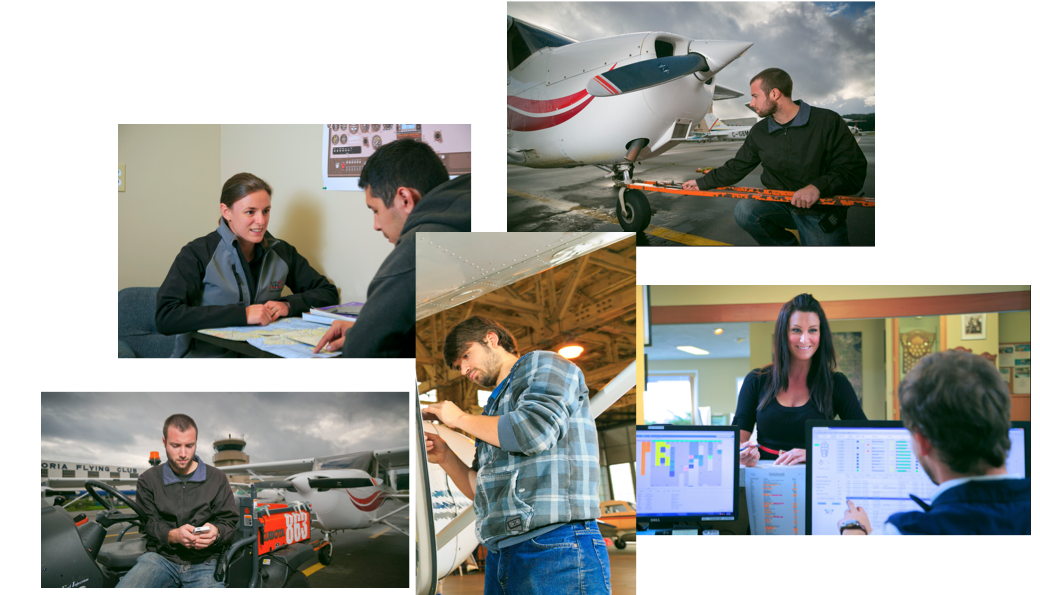Focus and Teamwork
Staff effectiveness is achieved in several ways:
• Everyone focusses on their own job, contributing the data they have and taking the data they need
• FleetCaptain organizes and presents the shared data to each person in the form that they need
• FleetCaptain helps co-ordinate the actions of all the team members
• Communication without interruption – FleetCaptain uses messaging to get straight to the point
• Work is queued – peaks and valleys are smoothed
• Staff have clear data so they can plan their time effectively
• Errors, exceptions and missing data are avoided – greatly easing the busiest periods
• … and much more. To review how FleetCaptain works in more detail, use the contact form and we’ll be in touch.
Enabling Support
Staff are made effective because they participate in a process that works. Processes work because they are enabled by a support system designed using the business logic of aircraft rental and flight training.
The base of the pyramid is FleetCaptain, the support system. The dispatcher uses the system to select aircraft for each mission, automatically, knowing each plane’s current location, fuel level, time remaining etc. Maintenance staff use a fleet-wide view to forecast their inspections, plan their time and materials. An inspection summary is automatically assembled and presented reducing administrative time. Lineman have an up-to-the-minute aircraft status in their hands so they make best use of their time. The system shares the data, organizes it for each function, pulling individual efforts together into one co-ordinated team effort.
The next level is the process level. Each person’s job flow is designed so that the required data is gathered, tasks are planned and done, then resulting data is contributed back to the system for others to use. This makes staff more effective by allowing each to focus on their own priorities and spend less time interrupting and co-ordinating with others.
Let’s look at 15 minutes in the life of a lineman.
Gathering: Scan the fleet overview to see which planes are out (and when they’re due back and how much fuel they’ll have when they return). Review the fuel levels of the planes on the ramp. Read any notes from the dispatchers.
Planning and doing: The next hour’s work is visualized – which planes will need fuel, how much and approximately when. Time is planned accordingly. Time NOT spent communicating and handling exceptions is re-directed at providing customers with attention on the ramp, cleaning aircraft etc. Fuel and oil is added to aircraft as the need arises, one at a time with no doubt about the intended fuel level, the priority order or the level of upcoming work.
Contributing back: Electronically note the amount of fuel and oil added. Move on.
There is no need to communicate with the dispatcher or maintenance staff. FleetCaptain does the communicating. The new fuel level is immediately used for mission planning and weight and balance calculations. The dispatcher focuses on managing customers at the counter, not handling interruptions from flight line staff. The oil record for each aircraft is up to date. It doesn’t matter who adds oil, or when it is done. The collective record is available at all times for maintenance staff to see and use. Again, there is no need for moving paper around or person-to-person communication between line and maintenance staff.
At the top of the pyramid are the people – the HR component.
Without a catalyst, flying club personnel tend to focus more on operating and less on business development. People apply their best efforts to making each day go well. There is not so much of an instinct to change things. But when people are consulted, then improvements planned, the cycle of business development begins. Some concern about change is to be expected in the early stages (will the new way work), but as the first small changes deliver rewards and the benefits become obvious, buy-in comes naturally.
As the results begin to compound, enthusiasm builds. Staff members look for opportunities to contribute to process development to further improve the way things are done. You start to hear “wouldn’t it be nice if…”, “how can we improve this…”, “could we possibly try…”, rather than “this is how we do it…”.
As the business becomes more profitable and successful, the staff members develop personally which further contributes to the cycle of success.



